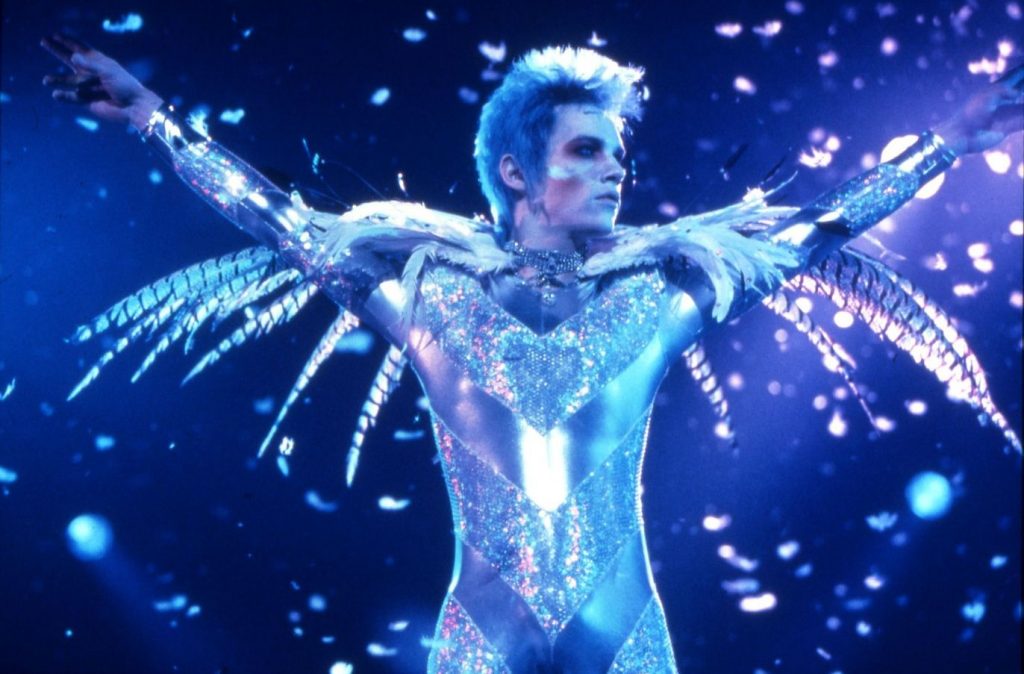He was a glam rock innovator whose music still appears on classic rock radio. He’s been cited as an influence on numerous bands, from the Replacements, the Smiths, and Siouxsie and the Banshees to Def Leppard and Guns-n-Roses. His androgynous visage and iconic album covers are screen-printed on high-fashion tee shirts. T Rex frontman Marc Bolan is still an influential figure across rock music subgenres, and the music he made is arguably more representative of the British glam scene than many of his peers.
After being inducted into the Rock and Roll Hall of Fame—by none other than Ringo Starr, who directed the Bolan documentary Born to Boogie —Bolan is the subject of the documentary Angelheaded Hipster: The Songs of Marc Bolan and T. Rex. Music fans who want to prolong their visit to the glittery nightclubs of 1970s England would be wise to seek out Velvet Goldmine, Todd Haynes’s free-associative love letter to the glam rock scene.
On paper, the film’s plot is deceptively simple. In a dystopian alternate universe version of 1984, journalist Arthur Stuart (Christian Bale) is assigned to write a retrospective on Brian Slade (Jonathan Rhys Meyers), a groundbreaking glam rock star who faked his own death ten years prior. As Stuart researches the elusive, boundary-pushing musician and interviews his peers and intimates, he starts to suspect a connection between Slade and the squeaky-clean arena rock star Tommy Stone (Alastair Cumming).
This description doesn’t capture Haynes’s nonlinear approach to the subject matter, nor his maximalist aesthetic in depicting the glam scene. The flashback-heavy structure, which quotes extensively from Citizen Kane, allows different characters to offer their recollection of the era and their relationship with Slade. Haynes frequently uses the subjectivity of memory as a theme in his movies—particularly those about rock stars or mass media figures—and he nimbly plays with the fan vs. insider perspective in a series of scenes in which Stuart interviews Slade’s ex-wife Mandy (Toni Collette). Her description of Brian’s career complements and contrasts with Stuart’s memories of the records he bought and the shows he attended as a young man.
By making Arthur Stuart the POV character, Haynes firmly places the audience in the perspective of glam rock fans. “Velvet Goldmine is ultimately about the active role the fan takes in this kind of pop moment, and it speaks by association to films and music that give you a role to play, that encourage your fantasies and your embellishment,” Haynes told Village Voice film critic Amy Taubin on its release. James Lyons’ elliptical editing feels at its best like a scrapbook a fan lovingly put together at the height of the era. In the warm, metallic palette Haynes used in the glam scenes, the handheld camera work of the concert sequences, and Collette and Ewan McGregor’s loose, lived-in performances, we understand the freedom Stuart felt at the glam movement and how it inspired him to explore his own sexuality.

When Velvet Goldmine was released in 1998, its notoriety came in part from its resemblance to actual persons and events. Haynes had initially conceived of the film as a David Bowie biopic, but when the groundbreaking figure withheld the rights to his catalog, Haynes edited his screenplay to remove references to Bowie, Iggy Pop, and other real-life figures. Eagle-eyed glam fans may recognize some peripheral characters who have similar analogues on the glam scene; look for Donna Matthews from Elastica as a stand-in for Suzi Quatro.
Marc Bolan was a different kind of rock star than David Bowie. While Bowie had moved on from glam in the early 1970s to experiment with more challenging forms of music, Bolan stuck with the hard rock and psychedelic folk of T Rex throughout his career. The straightforward pop singles he released, combined with his frequent television appearances, made him a more accessible entry point into glam rock for fans in the 1970s. In light of his relative ubiquity, it’s surprising that a Bolan stand-in doesn’t appear in Velvet Goldmine.
Bolan’s influence threads its way through the film in other ways. In a flashback to Stuart’s tumultuous adolescence, he is invited to live with the band Flaming Creatures (played by the Britpop band Placebo) after his parents throw him out of their home. The dialogue in their discussion about Arthur’s housing is inspired by the poetry Bolan had written, and Placebo singer Brian Molko brings out the humor in the pretentious-seeming verse with his winking line reading. (Molko also appears as an extra throughout the film, easy to spot in crowd scenes with a feathered top hat that evokes Bolan’s trademark headwear.) While the Flaming Creatures perform “20th Century Boy” at a live show, Haynes also incorporates two lesser-known T Rex songs as needle drops in key scenes; listen for “Cosmic Dancer” in the shot where the enigmatic-yet-influential Jack Fairy is introduced to the audience.
Unlike Angelheaded Hipster, Velvet Goldmine is a work of fiction. Todd Haynes was able to capture the lightning in a bottle that was the UK glam rock scene and share it with audiences in the 1990s and beyond who missed out on seeing Bowie, Iggy, and, yes, Marc for the first time. For those chasing the high that only a power chord played through a Marshall stack can supply, Velvet Goldmine is a must-watch.
“Velvet Goldmine” is available for digital rental or purchase.

